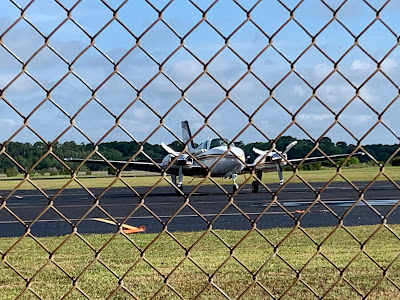I have been wanting to get night current again. To carry passengers, the FAA mandates that you must have made 3 landings to a full stop in the preceding 60 days. Day currency is easier, you have 90 days and the landings don't have to be to a full stop. The other twist is that night does not begin until 1 hour after sunset. Last night sunset was 8:30 PM and thus my landings had to be after 9:30 PM.
I had been looking for a good night, the last few had been really stormy or cloudy but yesterday it looked perfect. The skies were mostly clear, just high clouds, the winds light and the storms were slowly dissipating. I headed off to the airport early so I could do all my pre flight checks with good light. Once the plane was ready, I visited with another pilot working on his plane and watched the storms that had built North of the field.
It was a nice show, the storms were about 40 North and mostly moving East. You could see the lightning jumping out of the clouds in the twilight. As the light faded I headed to the plane and fired up a bit after 9 PM. Originally I was going to go to JAX for my first 2 landings. They have a 10,000 runway which provides plenty of room to come to a complete stop and then take off. The Storm location and the need to work around airline traffic inbound made me change my plans.
I would have gone to Cecil but the Notams had indicated the long runway was closed. I chose St. Augustine which ended up being a good choice. 8,000 feet and the control tower closed at 9 PM so I did not have to ask permission for my practice. Departing I headed South and then looped back North to see how the storms looked on the radar. They had moved a bit closer so I kept an eye on them as I didn't want my return to be cut off. The big picture looked ugly though, The South part of Florida was quite rainy.

I flew South of St. Augustine to waste a bit of time as I was early but soon was on the downwind to land. I had the airport to myself and this would be my first night landing in the Baron. Downwind I reset the pilot controlled lighting so it would stay on for my landing, gear was confirmed down and I had set the visual approach into the GPS so I would have both lateral and vertical guidance in the dark. The big displays and synthetic vision makes the approaches easy. The Baron also has 2 landing lights and a taxi light which provides plenty of illumination. St. Augustine has the new LED lighting which is really bright, almost too bright for my taste but would be nice on a foggy day. After the second landing I headed back home.

The winds on the ATIS were 240@10 so I was planning a 23 arrival. Checking in with tower he said things were shifting and winds were 030@5, did I want 32. I did and joined a long final for 32. While doing my landings I had seen the sky light up with the distant lighting. Heading North I had an amazing light show of some pretty extreme lightning. Now those towering storms were starting to impact my local weather. The wind was still 240@20 up at 2000 but the outflow from the storms was reversing the winds down low. At 3 miles out the tower advised me that the winds had shifted to 050@11 gusting 17.

New plan, I was cleared to circle to 5. I was watching the winds as I made my approach, expecting the wind shear. Going into a headwind is not a big issue as you gain some airspeed. Just as expected, at 200 feet the winds swapped from 10 knots tail to 10 knots head. My touchdown was good and tower cleared me all the way down to 32 for the taxi in. It had been a great night for practice but the weather was changing. I put the plane away and later it poured but I was already safe at home.





















